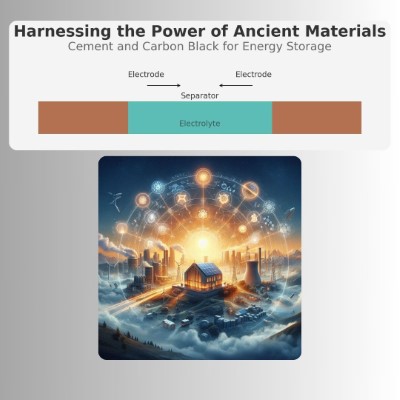In an innovative breakthrough, MIT engineers have developed a new supercapacitor that combines two ancient materials—cement and carbon black—with water to create a scalable, low-cost energy storage solution. This technology promises to revolutionize the storage and use of renewable energy, ensuring a stable energy supply despite fluctuations in solar, wind, and tidal power generation.
How It Works
Supercapacitors, unlike traditional batteries, store energy in an electric field created between two conductive plates immersed in an electrolyte. The key to the new supercapacitors developed by the MIT team lies in their method of creating a cement-based material with an exceptionally high internal surface area. Here’s a step-by-step breakdown of the process:
- Materials: The supercapacitor is made from a mixture of cement powder, carbon black (a highly conductive form of carbon), and water.
- Formation: As the mixture cures, the water forms a network of openings within the cement structure. Carbon black migrates into these spaces, creating wire-like structures with a fractal pattern—large branches sprout smaller branches, increasing the surface area significantly.
- Electrolyte Soaking: The hardened material is soaked in an electrolyte, such as potassium chloride. This allows charged particles to accumulate on the carbon structures, forming the basis of the supercapacitor.
- Assembly: Two plates of this material, separated by a thin insulating layer, function as the supercapacitor, capable of storing and quickly releasing electrical energy.
Benefits
The new supercapacitor technology offers several significant advantages:
- Low Cost: Both cement and carbon black are inexpensive and widely available materials.
- Scalability: The energy storage capacity is directly related to the volume of the electrodes, making the system easily scalable from small devices to large infrastructure.
- Durability: The material retains the structural strength of concrete, allowing it to be used in construction without compromising integrity.
- Rapid Charge/Discharge: Supercapacitors can be charged and discharged much faster than traditional batteries.
- Versatility: The technology can be applied in various forms, such as house foundations, roadways, and more.
Future Applications
The potential applications for this technology are vast:
- Residential Energy Storage: Concrete foundations of houses could store a day’s worth of energy, providing stability for solar or wind power systems.
- Roadway Charging Systems: Concrete roadways embedded with supercapacitors could wirelessly charge electric vehicles as they travel, utilizing solar panels installed alongside the road.
- Remote Power Solutions: Isolated buildings or shelters could be powered by solar panels connected to cement supercapacitors, offering a reliable off-grid energy solution.
Limitations and Challenges
Despite its promise, the technology faces several challenges:
- Optimization of Mixture: There is a trade-off between energy storage capacity and structural strength. Higher carbon content increases storage but weakens the concrete, necessitating precise optimization for specific applications.
- Long-term Durability: The long-term durability and performance of the supercapacitors under various environmental conditions need further study.
- Integration into Existing Infrastructure: Adapting current construction practices and standards to incorporate this new technology may require significant changes.
Conclusion
The development of supercapacitors from cement and carbon black represents a significant step forward in the quest for efficient, scalable energy storage solutions. By leveraging these ancient materials, MIT engineers have opened new avenues for the integration of renewable energy into everyday infrastructure. This multifunctional material not only addresses the pressing need for energy storage but also reimagines the future of construction and energy systems.
As research progresses and the technology matures, we can expect to see a growing number of applications that harness the power of these ancient materials to create a more sustainable and resilient energy future.
Reference: MIT News
